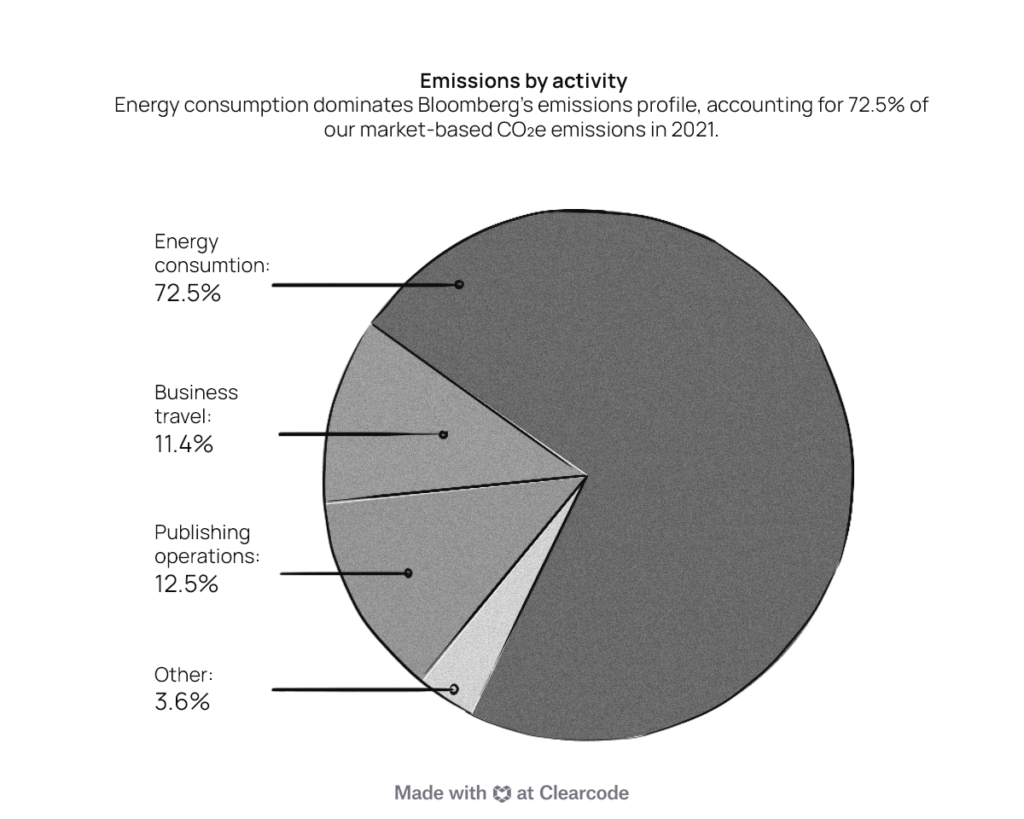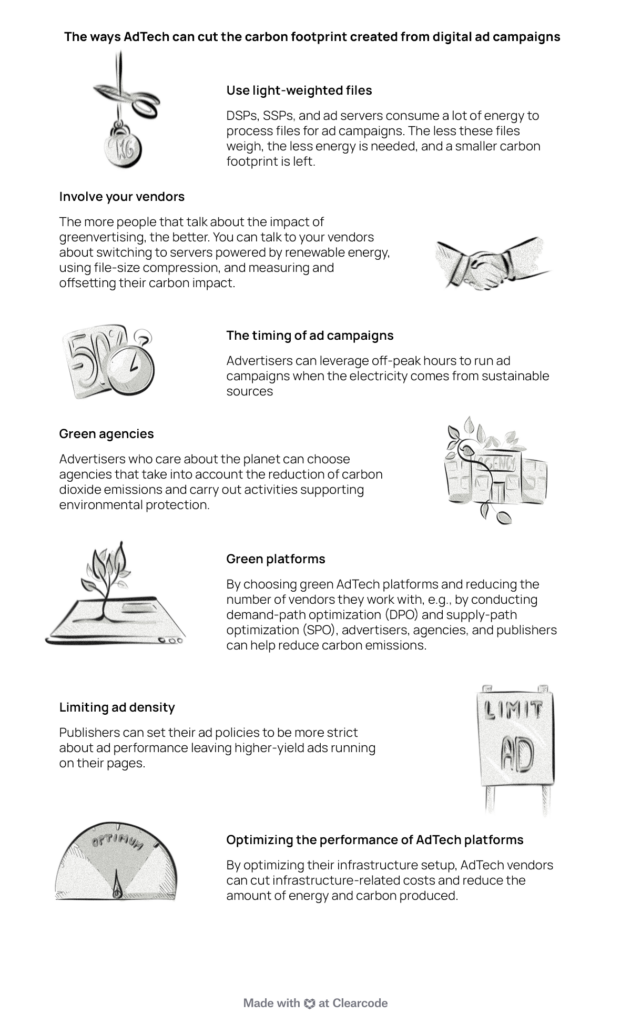Carrying out massive amounts of auctions, data transfers, and ads serving requires vast computing powers, and with that requirement comes carbon dioxide emissions that AdTech produces daily.
Climate change is no longer a discussion. It is an issue that needs action and one that is top of mind for consumers, brands, media agencies, and investors. The need to move toward a greener future has led the programmatic industry to review its role in producing emissions and how it can reduce them.
But will the programmatic advertising industry treat it as a temporary trend, or will it stay with us for a longer time? And will the industry incorporate new green standards to reduce its carbon footprint?
Key Points
- A report published by fifty-five calculated the total emissions for a mock digital advertising campaign came to 323 tons of CO2eq, which is roughly the annual carbon footprint of 16 American citizens.
- The Internet produces around 4% of greenhouse gas emissions worldwide, which is bigger than the aviation industry.
- There are four ways emissions are produced via online activities: Rendering web pages, data transmission through 5G or WiFi, content production, and targeting and analytics.
- In 2021, CLICKON found that 32% of surveyed UK brands want to be carbon neutral by the end of 2023.
- Programmatic advertising and AdTech can reduce CO2 emissions by using lighter files for creatives, working with companies that are focused on reducing their carbon footprint, and optimizing their infrastructure setup to cut infrastructure-related costs and reduce the amount of energy and carbon produced.
How Many CO2 Emissions Does an Advertising Campaign Produce?
Calculating the number of CO2 emissions from programmatic advertising campaigns can be tricky as there are many factors to consider, such as travel for creative production and the electricity used by servers.
A report published by fifty-five calculated the total emissions for a mock digital advertising campaign came to 323 tons of CO2eq, which is roughly the annual carbon footprint of 16 American citizens.
In the chart below, you can see which channel potentially generates the most carbon dioxide regarding the mock Perfume 2022 campaign.

But it’s not only advertisers that leave a carbon footprint. In fact, the whole industry contributes to gas emissions.
Bloomberg, one of the biggest publishers in the U.S, took a close look at how much energy they consume and thus how much carbon dioxide they emit.

In fact, the Internet is responsible for producing around 4% of greenhouse gas emissions worldwide, which is bigger than the aviation industry.
Brian O’Kelley, Scope3’s CEO, said that there are four ways emissions are produced via online activities:
- Rendering web pages.
- Data transmission through 5G or WiFi.
- Content production.
- Targeting and analytics.
In other words, everything that we do online ends up creating a big carbon footprint.
It’s no wonder why organizations such as Scope3, GoodLoop, and the Climate Action Working Group, which was set up by the Advertising Association, emerged in the AdTech industry.
These companies and bodies examine and address the pounding problems associated with carbon emissions by offering a set of different tools, such as:
- A carbon calculator to calculate the amount of carbon dioxide produced in advertising (AdGreen).
- A green ad tag to estimate the emission in digital ad campaigns and plant a tree for every thousand impressions purchased (Good-Loop).
- A media owner showcase page to highlight important steps taken by prominent brands (IPA Media).
- A comprehensive analytical tool to identify where the emission can be reduced (Publicis Groupe).
However, AdTech has just begun to incorporate positive practices, and there is still a lot of work to be done.
We Can Help You Build an AdTech Platform
Our AdTech development teams can work with you to design, build, and maintain a custom-built AdTech platform for any programmatic advertising channel.
The Space for Innovations
The green trends create the space for innovators, from manifests and tech stacks to media supply chains. There are opportunities in all of these fields to rethink the way we shape the industry and programmatic advertising in particular.
“There’s a lot of room in the programmatic advertising industry to develop greener solutions. Advertisers, publishers, and AdTech companies can not only follow reports such as Ad Net Zero but make changes to their technology and technical process to reduce the carbon footprint. Green innovation is good for the planet and for revenue,” said Piotr Banaszczyk, CEO at Clearcode.
And the Space for Misinformation
As the eco trends appeared in the mainstream, the negative phenomenon of greenwashing also showed up. Greenwashing is the term for abusing green arguments in advertising, meaning that some companies purposely exaggerate the positive benefits their products or services have on the environment.
An example of greenwashing is a drink commercial from The Innocent. After going public, it received 26 complaints that challenged the idea that the company’s products help the planet.
Examples like this often cause companies to hold back from publicly announcing their green initiatives, even if their initiatives are actually beneficial for the environment, as they’re afraid of the negative backlash they may receive.
In a recent LinkedIn post, Brian O’Kelly proposed a new term: Greenworking.
“I propose greenworking. If greenwashing is trying to trick people into thinking you’re doing more than you are, greenworking is telling people the truth about where you are and what you’re doing.” O’Kelly said in the post.
Greenwashing can be limited by incorporating the standards set out in the International Chamber of Commerce (ICC) Framework for Responsible Environmental Marketing Communications.
Besides greenwashing, some advertisers show their ads on video clips that promote climate misinformation on purpose, meaning that they are helping fund the content creators that produce this misinformation. In 2020, more than 100 brands ran such ad campaigns on YouTube, according to Videoweek.
Going Green in AdTech: Is It a Sprint or a Marathon?
In 2021, CLICKON found that 32% of surveyed UK brands want to be carbon neutral by the end of 2023. It sounds like a sprint that, when it ends, will be forgotten.
In fact, to be effective, we need to tackle the issue of advertising’s climate impact as if it were a marathon.
Ad Net Zero is calling on the AdTech industry to reduce the carbon output to real net zero by the end of 2030. A longer perspective creates a space to take well-thought actions and collaborate with other organizations such as governments.
Sustainability was the key topic of the week at Cannes LIONS in June. It turns out that brands want to know what carbon footprint is left by broadcasted advertisements, and many advertisers are starting to include a checklist of ‘sustainability criteria’ when selecting publishers.
How Can AdTech Reduce Its Carbon Footprint by Limiting Inefficiencies?
In an interview for Digiday, Marc Guldimann, Adelaide’s CEO said:
“What we’ve found is that because high attention campaigns can use less impressions to deliver the same outcomes — because there’s less waste from garbage impressions that no one pays attention to — there’s actually far fewer emissions from a campaign that’s optimized using attention data, than there ones using viewability or video completion rate. Those metrics make you buy lots of little tiny little crappy ads. And viewability is still Sustainable Programmatic Advertising and AdTech: The Need to Go Green way more popular [metric] than attention.”
The Benefits of Reducing Your Advertising Campaign’s Carbon Footprint?
The goal of green programmatic advertising is to limit carbon dioxide emissions by any means possible to help stop climate change. So the most basic reason for adopting a low-carbon approach is simply to help the planet. But for business, the benefits can be more tangible.
Good Publicity
From the PR point of view, you can leverage your green activity to your advantage. Brands such as Sharethrough, PubMatic, Picnic, and GoodLoop share news every time they launch a new green platform, switch to a renewable-energy-based infrastructure, or measure and compensate for the cost of media campaigns’ supply chain emissions. They also team up for the good of our planet.
Consumer Trust
Putting the Earth at the heart of how you conduct your business can positively impact your reputation. Eco is an important topic right now, and many consumers worry about climate change.
Cost Savings
Calculating your carbon emissions can point out the areas of your business that you need to change. By adopting a low-carbon approach and choosing an AdTech platform that’s focused on reducing emissions, you can not only help fight climate change but also reduce costs.
Job Satisfaction
91% of surveyed employees claimed they would be more satisfied with their jobs if employers take action to reduce the carbon footprint made by their companies.
How Can AdTech Reduce CO2 Gas Emissions?

There are several ways to reduce carbon dioxide emissions and reduce the carbon footprint of a digital ad campaign.
- Use light-weighted files
DSPs, SSPs, and ad servers consume a lot of energy to process files for ad campaigns. The less these files weigh, the less energy is needed, and a smaller carbon footprint is left. - Involve your vendors
The more people that talk about the impact of greenvertising, the better. You can talk to your vendors about switching to servers powered by renewable energy, using file-size compression, and measuring and offsetting their carbon impact. - The timing of ad campaigns
Advertisers can leverage off-peak hours to run ad campaigns when the electricity comes from sustainable sources. - Green agencies
Advertisers who care about the planet can choose agencies that consider the reduction of carbon dioxide emissions and carry out activities supporting environmental protection. - Green platforms
By choosing green AdTech platforms and reducing the number of vendors they work with, e.g., by conducting demand-path optimization (DPO) and supply-path optimization (SPO), advertisers, agencies, and publishers can help reduce carbon emissions. - Limiting ad density
Publishers can set their ad policies to be more strict about ad performance, leaving higher-yield ads running on their pages. - Optimizing the performance of AdTech platforms
By optimizing their infrastructure setup, AdTech vendors can cut infrastructure-related costs and reduce the amount of energy and carbon produced.
We Can Help You Build an AdTech Platform
Our AdTech development teams can work with you to design, build, and maintain a custom-built AdTech platform for any programmatic advertising channel.





